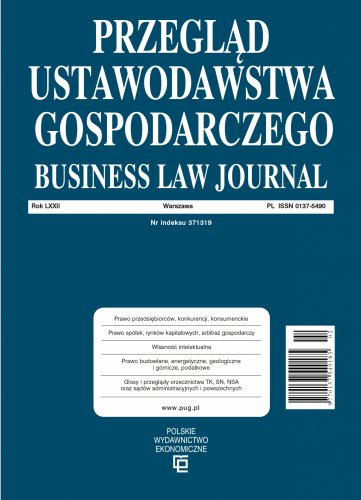Group of companies in insolvency and restructuring proceedings: common solutions for common problems. A comparative perspective
Corporate groups regardless of their structure are a common phenomenon in conducting business activity, therefore there was a need to address the problem of insolvency of such groups by legislators. The following paper presents regulations regarding corporate insolvency provided in both supranational acts (UNCITRAL Legislative Guide on Insolvency and EU Regulation 2015/848 on insolvency proceeding), as well as in national laws of four EU Member States — Italy, the Netherlands, Poland and Portugal. As shown in the study, each of the above mentioned countries allows conducting insolvency proceedings with respect to corporate groups, albeit with some differences as to its basis (legal acts or legal practise), scope (coordination, procedural consolidation or substantial consolidation) and implementation (court jurisdiction and appointment of supervisory judges or insolvency practitioners). In the paper we compare the regulations adopted by the states in question and point out some obstacles for effective proceedings. Despite some differences, we find most of the solutions similar as they allow consolidation or coordination of cases, and they are in line with the European law on insolvency.
References
Bibliografia/References
Abete, L. (2018). Concordato preventivo di "gruppo": presupposti ed opzioni alternative, Il fallimento e le altre procedure concorsuali, (2), 179 ff.
Adamus, R. (2019). Prawo upadłościowe. Komentarz. Warszawa: C.H.Beck.
Becker, M. (2012). Kooperationspflichten in der Konzerninsolvenz. Koln: Verlag Komunikationsforum.
Benedetti, L. (2017). I flussi informative nella crisi del gruppo. Giurisprudenza commerciale, I, 271–303.
Benedetti, L. (2019). Osservazioni sulla nuova disciplina della crisi del gruppo di societa, materiali per il corso di perfezionamento su "Il nuovo diritto fallimentare" svoltosi presso l'Universita di Firenze il 27 febbraio e il 14 marzo 2019. In: I. Pagni, L. Stanghellini (eds), Il nuovo diritto fallimentare I, p. 122 ff.
Bous, U. (2001). Die Konzernleitungsmacht im Insolenzverfahren konzernverbundener Kapitalgesellschaften. Köln, Berlin, Bonn, München: Heymann.
Buck, S. (2014). Planned insolvency law reforms — draft act for facilitating the handling of groups insolvencies. Insolvency and Restructuring in Germany, https://www.schultze-braun.de/fileadmin/de/Fachbuecher/Insolvenzjahrbuecher/Insolvenzjahrbuch-2014/Yearbook2014.pdf?_=1404467382 (30.06.2019).
Fabiani, M. (2016). Concordato preventivo e gruppo di societa: colpito ma non affondato. Il Foro Italiano, 1372 ff.
Fauceglia, G. (2016). Uno, nessuno, centomila: il concordato preventivo di gruppo. Giurisprudenza commerciale, II, 118 ff.
Filipiak, P., Hrycaj, A. (2017). Prawo restrukturyzacyjne. Komentarz. Warszawa: Wolters Kluwer.
Flöther, L. (2015). Handbuch zum Konzerinsolvenzrecht. München: C.H.Beck.
Gispen, G., Van Gangelen, B. (2018). Insolvency and Directors' Duties in The Netherlands: overview, https://uk.practicallaw.thomsonreuters.com/1-635-9172?transitionType=Default&contextData=%28sc.Default%29. (2.07.2019).
Janda, P. (2019). Prawo upadłościowe. Komentarz. Warszawa. Wolters Kluwer.
Kruczalak-Jankowska J., Machnikowska A., Maśnicka M. (2019). Działalność sądów w postępowaniach restrukturyzacyjnych i upadłościowych: bariery funkcjonowania i instrumenty poprawy systemu upadłościowego w Polsce, Gdańsk: Wydawnictwo Uniwersytetu Gdańskiego.
Lutter, M., Scheffler, E., Schneider, U. (1998). Handbuch der Konzernfinanzierung. Köln: Verlag dr. Otto Schmidt.
Mevorach, I. (2007). Appropriate Treatment of Corporate Groups in Insolvency: A Universal View. European Business Organization Law Review, 8(2), 179–194.
Mevorach, I. (2013). Is the future bright for enterprise groups in insolvency? An analysis of UNCITRAL's new recommendations. In: P. Omar (ed.), International Insolvency Law: Challenges and Reforms (363 ff). Abingdon-on-Thames: Routledge.
Paulus, G. (2004). Kurzkommentar zu AG München EWiR — Entscheidungen zum Wirtschaftsrecht, Art. 3 EUInsO VO (2/04).
Piepenburg, H. (2004). Faktisches Konzerninsolvenzrecht am Beispiel Babcock Borsig, Neue Zeitschrift fur Insolvenz- und Sanierungrecht (NZI), 231 ff.
Reumers, M. (2007). Samengevoegde afwikkeling van faillisementen. Wolters Kluwer.
Santagata, R. (2016). Il concordato di gruppo nel Progetto di riforma Rordorf: prime impressioni. Rivista di diritto dell'impresa, 681 ff.
Thole, C., Duenas, M. (2015). Some observations on the new group coordination procedure of the reformed European insolvency regulation. International Insolvency Review, 214 ff.
Van Calster, G. (2016). COMIng, and Here to Stay: The Review of the European Insolvency Regulation. European Business Law Review, 27(6), 747 ff.
Wessels, B. (2009). The Ongoing Struggle of Multinational Groups of Companies under the EC Insolvency Regulation. European Company Law (6).
Wessels, B. (2015). International Insolvency Law Part I. Global Perspectives on Cross-Border Insolvency Law. Deventer: Wolters Kluwer.
Wessels, B., Madaus, S. (2017). Instrument of the European Law Institute — Rescue of Business in Insolvency Law. https://ssrn.com/abstract=3032309 (30.06.2019).
Witosz, A. J. (2017). Prawo upadłościowe, Komentarz. Warszawa: Wolters Kluwer.
Zimmerman, P. (2018). Prawo upadłościowe. Prawo restrukturyzacyjne. Komentarz. Warszawa: C.H.Beck.

